Imagine sipping a cool drink on a sunny patio. Lush green plants surround you. A refreshing mist fills the air. This modern outdoor cooling system makes our warm days more enjoyable. You can find these misting systems in busy restaurant patios and quiet backyard retreats. They increase comfort and help businesses attract more customers.
This guide explores outdoor cooling benefits, technologies, and uses. Homeowners and business owners alike can transform their spaces, beating the heat and maximizing outdoor potential.
Key Takeaways:
- Outdoor cooling solutions significantly extend usable outdoor time in hot climates
- Various technologies available, from misting systems to high-tech fans
- Energy-efficient and eco-friendly options are increasingly popular
- Improves comfort, productivity, and property value
- Suitable for residential, commercial, and industrial applications
1. The Cool Revolution: Types of Outdoor Cooling Solutions
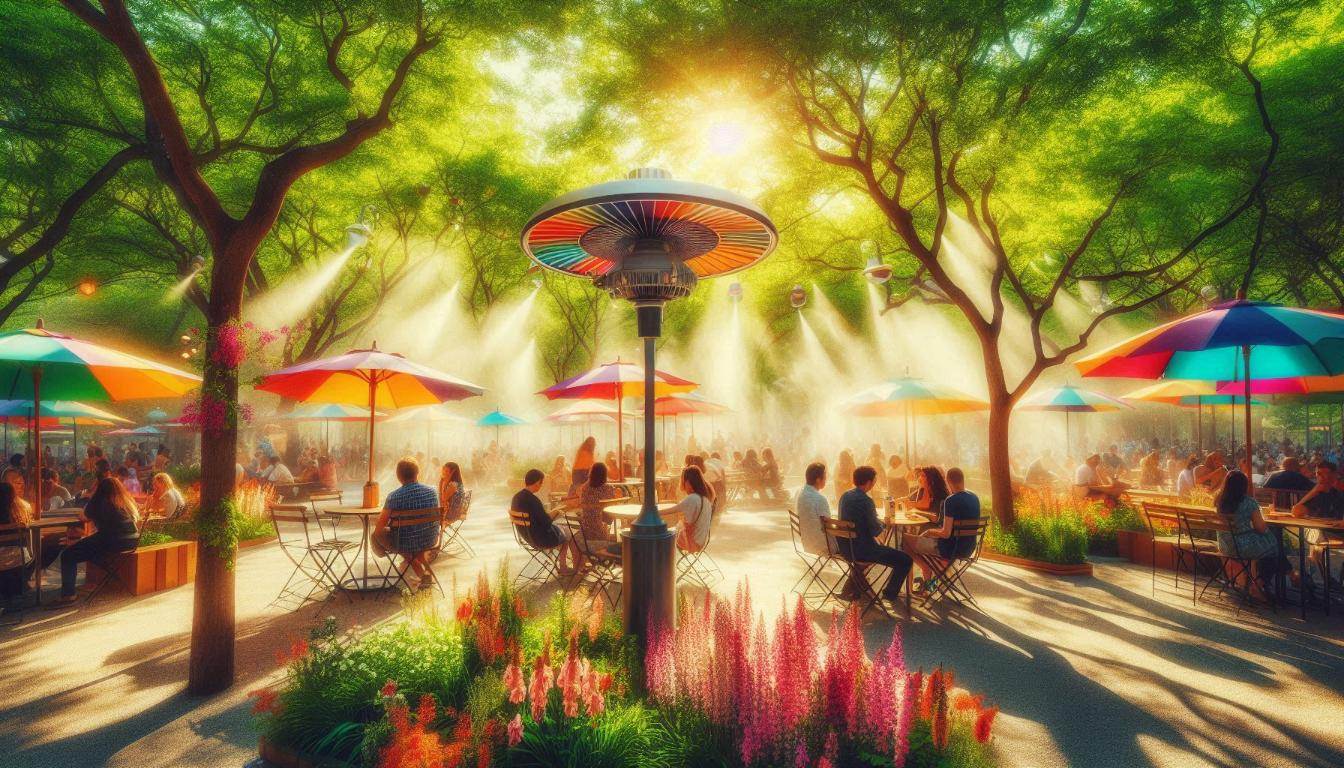
When it comes to outdoor cooling, one size definitely doesn’t fit all. The market offers a plethora of options, each with its unique advantages. Let’s break down the most popular types:
Misting Systems
These systems release fine water droplets into the air, which evaporate quickly to cool the area, ideal for dry climates. They can lower temperatures by up to 20°F (11°C). Common in restaurant patios, theme parks, and residential backyards.
Evaporative Coolers
Also called swamp coolers, these units use water evaporation to cool air. They’re more energy-efficient than traditional AC and work best in low-humidity areas.
High-Velocity Fans
From industrial-grade HVLS fans to portable ones, these can make you feel up to 10°F (5.5°C) cooler. They’re versatile for use in warehouses to outdoor cafes.
Spot Coolers
These portable air conditioning units are perfect for targeted cooling in outdoor events or work areas. They’re powerful and can cool specific zones quickly.
Shade Structures
While not active cooling solutions, pergolas, awnings, and shade sails play a crucial role in reducing heat gain and creating cooler outdoor spaces.
Each solution works well in different situations. Often, combining methods gives the best results. For example, a restaurant might use misting systems around its edges. It could also use strong fans in the seating area to make it more comfortable for guests.
2. Energy Efficiency and Eco-Friendliness: Cooling Without the Guilt
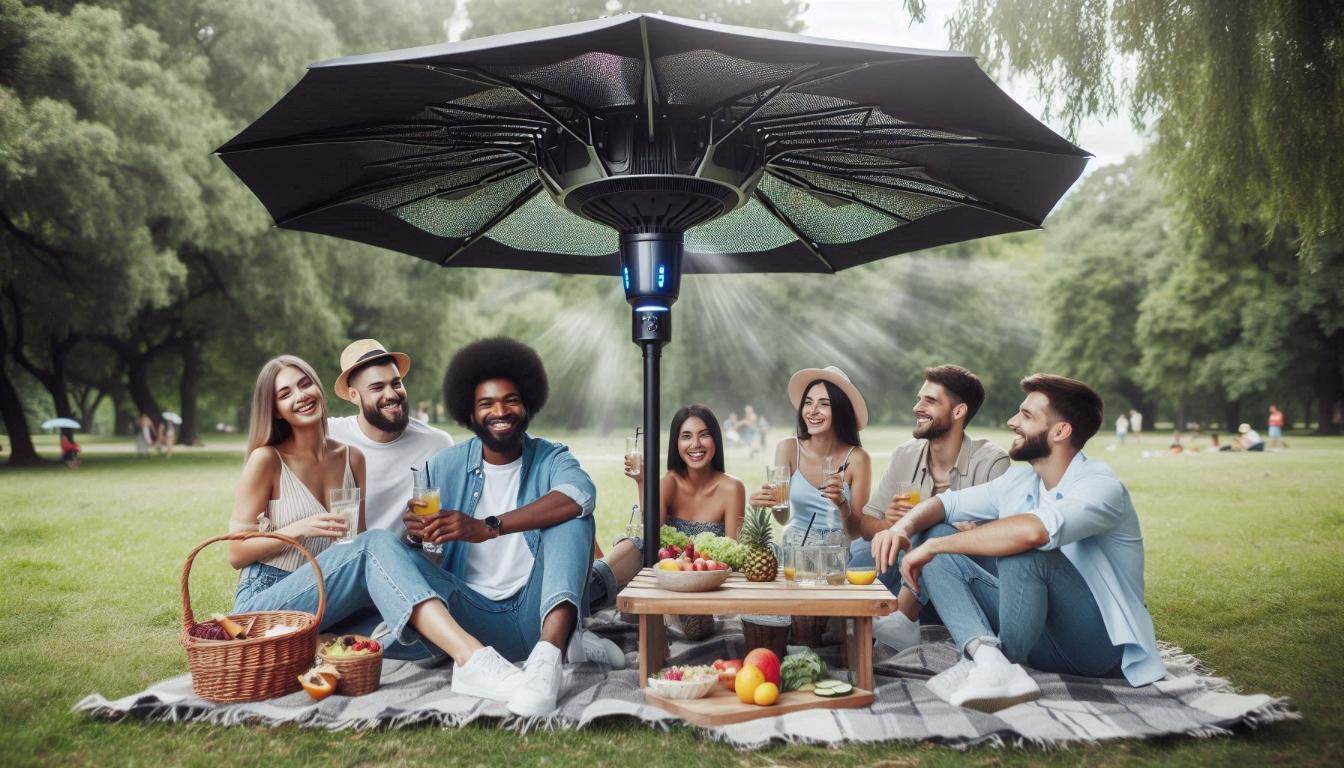
As environmental awareness grows, eco-friendly outdoor cooling solutions are increasingly vital. Modern systems prioritize energy efficiency and sustainability, helping people stay cool with minimal environmental impact.
Evaporative coolers, for example, use up to 75% less energy than traditional air conditioning systems. Properly designed misting systems use minimal water, evaporate quickly, and some recycle water to reduce consumption.
Solar-powered fans and cooling systems can operate off-grid, useful in remote or outage-prone areas, and reduce indoor air conditioning needs.
Eco-friendliness involves using recyclable materials and longer-lasting products. Innovations like biodegradable misting fluids and smart systems optimizing energy use are emerging, making outdoor cooling greener.
3. Health and Comfort: More Than Just Feeling Cool
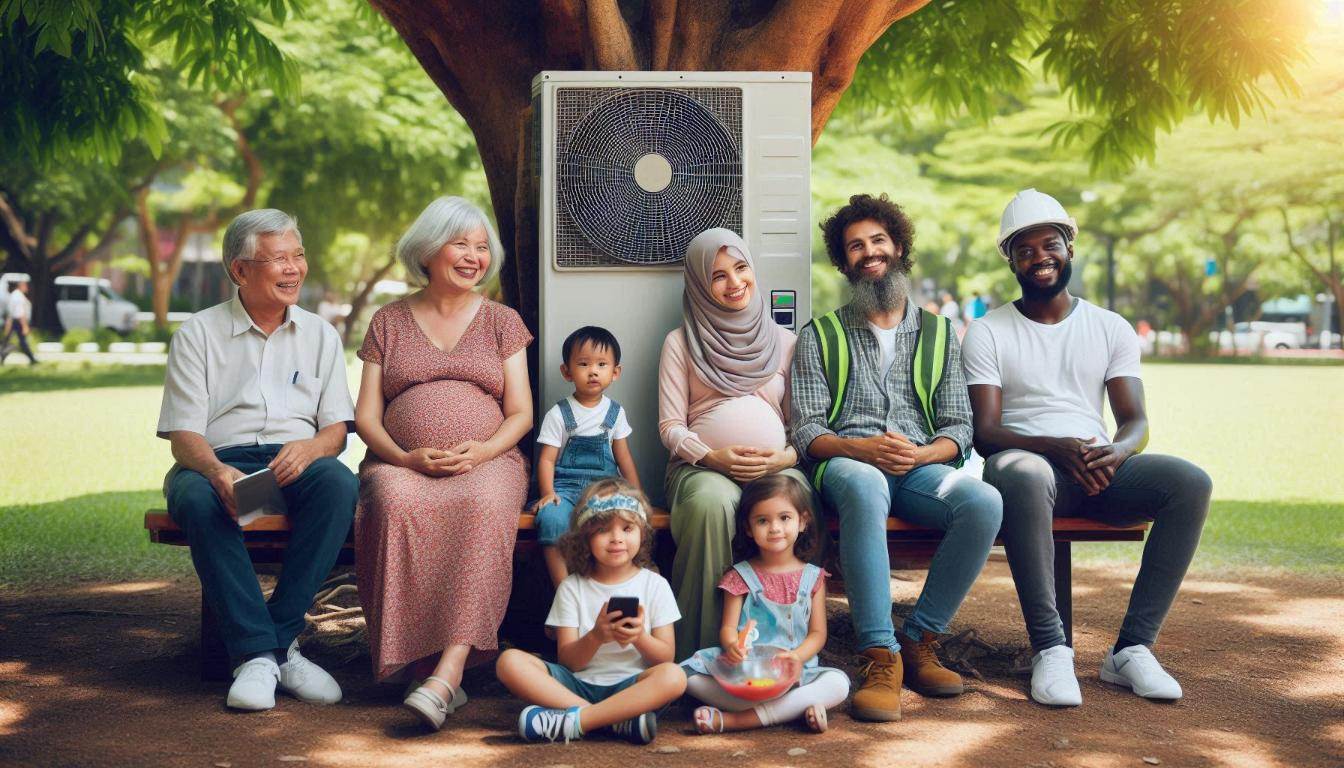
Outdoor cooling solutions offer significant benefits beyond temperature control. They enhance health, comfort, and overall well-being for outdoor activities.
These systems prevent heat-related illnesses, crucial as global temperatures rise. They protect vulnerable groups like the elderly and children, creating safer outdoor spaces for all.
Misting systems, in particular, offer additional health benefits. The fine water particles they release can help:
- Reduce airborne dust and pollen
- Increase air humidity, benefiting those with respiratory issues
- Neutralize odors and some airborne bacteria
Businesses gain advantages from having comfortable outdoor spaces. Customers feel happier, and employees work more productively. Restaurants can keep outdoor dining areas open. Retail stores can set up attractive displays outside. Workplaces can remain productive even when it’s hot outside.
Psychological benefits of outdoor time include reduced stress, improved mood, and boosted creativity. Outdoor cooling solutions ensure these benefits even in hot climates.
Socially, cooler outdoor spaces foster community interaction, enhancing overall well-being through gatherings like block parties and park visits.
For pet owners, outdoor cooling solutions provide safe, comfortable outdoor time for animals, preventing heat-related issues.
4. Economic Impact: Cooling That Heats Up Profits
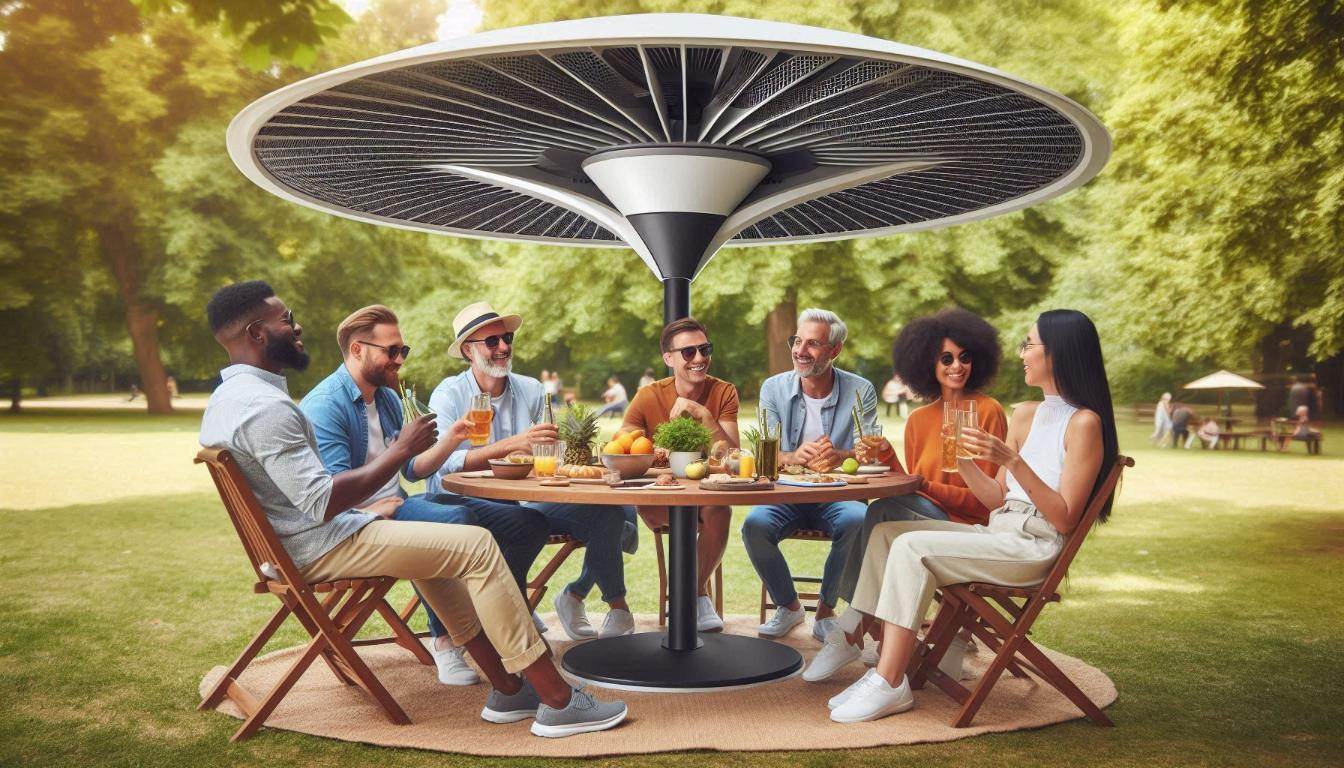
Implementing outdoor cooling solutions positively impacts businesses and property values. Here’s how these systems contribute to economic growth and profitability:
Extended Operating Hours and Seasons
Cooling solutions extend operating hours and usage of outdoor spaces for businesses. Restaurants and cafes can keep patios open longer, potentially boosting summer revenue by 30% or more.
Increased Foot Traffic and Dwell Time
Cooled outdoor areas in retail establishments increase foot traffic and customer dwell time, leading to more browsing and purchases.
Property Value Enhancement
For homeowners, outdoor cooling systems can increase property values by adding a valuable amenity. A well-designed outdoor space with cooling features is a selling point in hot climates.
Productivity Boost
In industrial settings, outdoor cooling boosts productivity. Worker output can drop by 4% for every degree above 80°F (27°C). Keeping workers cool maintains productivity and reduces heat-related work stoppages.
Energy Cost Savings
Despite initial costs, outdoor cooling solutions offer long-term energy savings compared to cooling large indoor spaces, especially with energy-efficient options like evaporative coolers or solar-powered systems.
Competitive Advantage
Businesses with cooled outdoor spaces gain a competitive edge. Hotels with cool poolside areas or zoos with misted walkways attract more customers and justify premium pricing.
Here’s a quick comparison of potential ROI for different businesses implementing outdoor cooling:
| Business Type | Potential Revenue Increase | Payback Period |
|---|---|---|
| Restaurants | 20-40% during summer | 1-2 seasons |
| Retail | 15-25% in foot traffic | 2-3 years |
| Hotels | 10-20% in bookings | 1-3 years |
| Events Venues | 30-50% more bookings | 1 season |
While the initial cost of implementing outdoor cooling solutions can be significant, the long-term economic benefits often outweigh the investment, making it a smart choice for many businesses and property owners.
5. Versatility and Customization: Cooling Solutions for Every Space
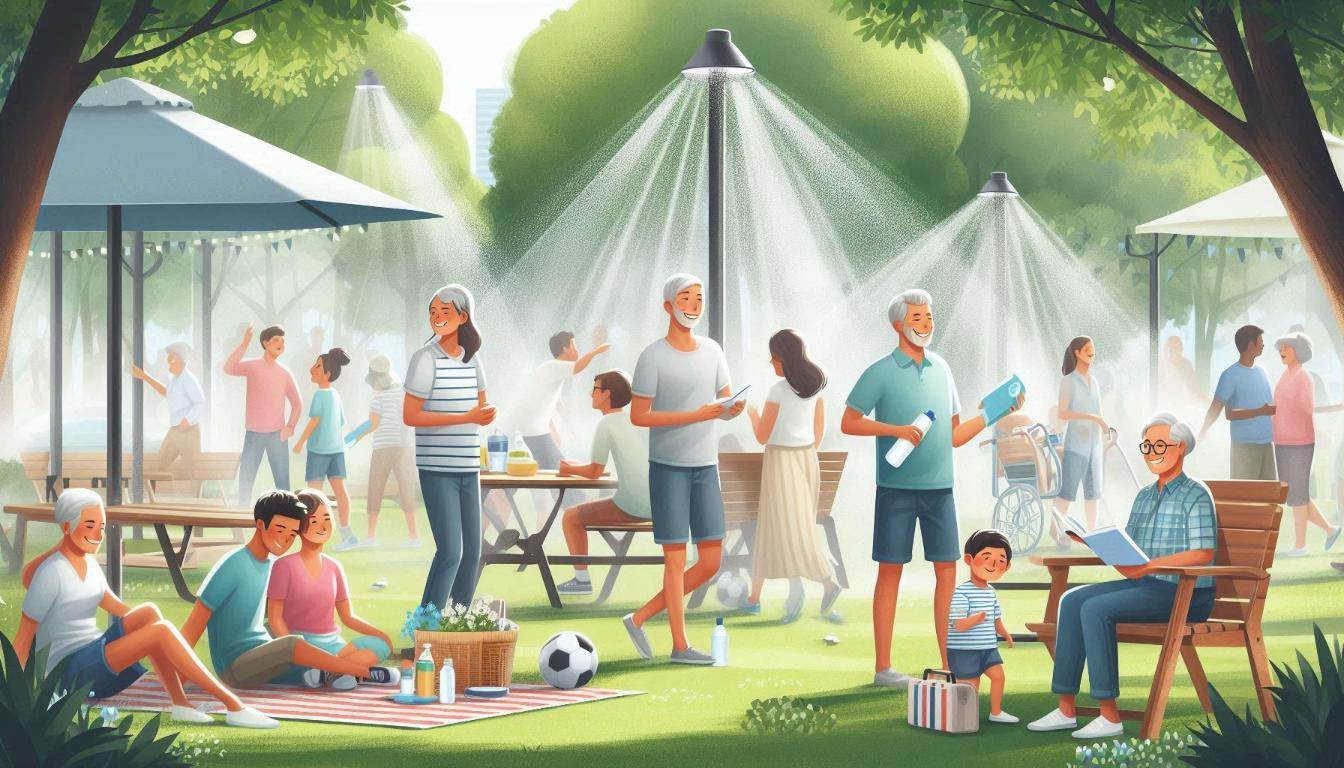
A key aspect of outdoor cooling solutions is their versatility. These systems can be tailored for any outdoor space, from small patios to large commercial venues. This adaptability makes outdoor cooling appealing for many uses.
Residential Applications
- Patios and Decks: Portable misting fans or overhead misting systems can transform a hot deck into a cool oasis.
- Pool Areas: Poolside misting systems enhance the refreshing atmosphere.
- Outdoor Kitchens: High-velocity fans keep cooks comfortable while grilling.
- Gardens: Misting systems can double as irrigation for plants while cooling the area.
Commercial Applications
- Restaurants: Combination of misting systems and fans for dining patios.
- Retail Spaces: Cooling for outdoor shopping areas or entrance cooling for a welcoming atmosphere.
- Hotels and Resorts: Cooling solutions for pool areas, outdoor bars, and recreational spaces.
- Sports Venues: Misting systems and large HVLS fans for spectator comfort.
Industrial Applications
- Warehouses: HVLS fans for large, open spaces.
- Manufacturing Plants: Spot coolers for specific work areas.
- Agriculture: Misting systems for livestock comfort and crop protection.
Public Spaces
- Parks: Misting stations or cooled shade structures.
- Transit Areas: Cooling solutions for outdoor waiting areas.
- Zoos and Theme Parks: Misting systems along walkways and in animal habitats.
These systems can grow with your needs. You can also adjust them to fit your space. For a small patio, a simple portable cooler might work. For a large commercial area, you might need a more advanced system. This could include several different cooling technologies working together.
Many solutions are modular, allowing for easy expansion and reconfiguration. This flexibility lets businesses and homeowners start small and scale up over time.
Aesthetics improve flexibility too. Systems can blend with current building designs. For example, misting nozzles can be hidden. Fans can look like art pieces. These systems can fit any style choice.
The adaptability of outdoor cooling solutions ensures that regardless of the space or specific needs, there’s a way to create a comfortable outdoor environment. This versatility is key to their growing popularity across various sectors.
6. Maintenance and Longevity: Keeping Your Cool for Years to Come
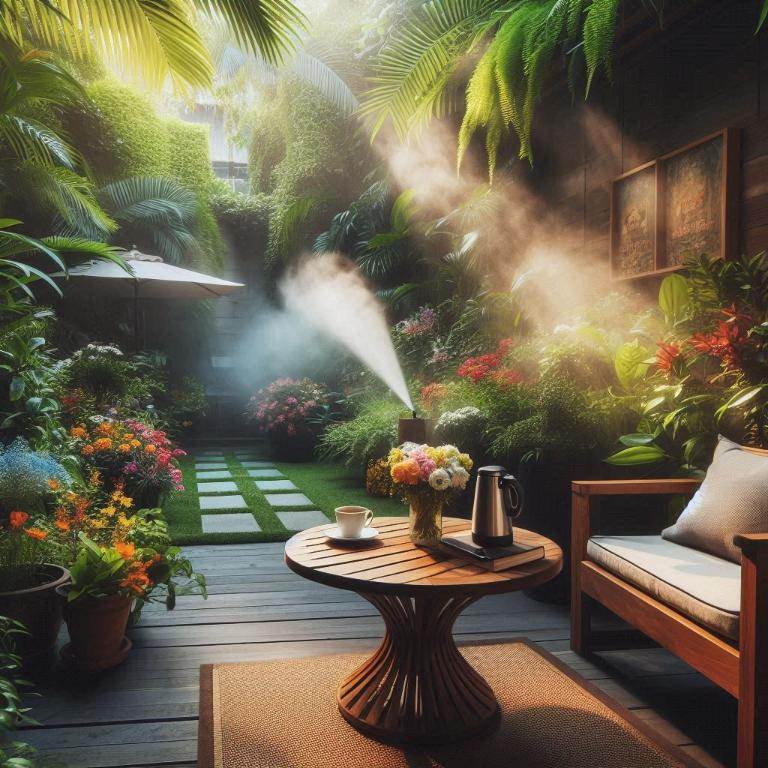
Investing in an outdoor cooling solution is just the beginning; proper maintenance is essential for longevity and performance. Thankfully, many modern systems are easy to maintain and can offer reliable service for years with proper care.
Here’s a general maintenance guide for common outdoor cooling systems:
- Misting Systems
- Clean nozzles regularly to prevent clogging
- Check for leaks and repair promptly
- Flush the system periodically to prevent mineral buildup
- Replace filters as recommended by the manufacturer
- Evaporative Coolers
- Clean or replace cooling pads seasonally
- Drain and clean the water reservoir regularly
- Check and tighten belt tension (for belt-driven models)
- Lubricate moving parts as needed
- High-Velocity Fans
- Clean blades and grills regularly
- Check and tighten all fasteners
- Lubricate bearings according to manufacturer’s instructions
- Inspect electrical connections annually
- Spot Coolers
- Clean or replace air filters monthly during heavy use
- Check and clean condenser coils
- Ensure proper drainage of condensate
- Have a professional service the unit annually
Regular cleaning and inspection at the start and end of each cooling season ensure optimal performance and longevity of systems.
Outdoor cooling solutions have varied lifespans based on system type, component quality, and maintenance levels:
- Misting Systems: 5-10 years
- Evaporative Coolers: 15-20 years
- High-Velocity Fans: 10-20 years
- Spot Coolers: 10-15 years
Manufacturers often offer warranties from 1 to 5 years for residential systems and longer for commercial-grade equipment.
Many modern systems have smart features that alert owners to maintenance or issues. A well-maintained cooling system lasts longer, operates more efficiently, saves energy, and reduces costs. Caring for your outdoor cooling ensures years of comfort.
7. Future Trends: The Cool Road Ahead

With advancing technology and rising environmental concerns, outdoor cooling solutions are becoming innovative. Here are some future trends:
Smart Integration
Outdoor cooling systems are now more connected and intelligent:
- IoT-enabled controls via smartphone apps
- AI-powered adjustments based on weather and usage
- Integration with smart home systems
Sustainable Materials and Practices
Sustainability is fostering innovations like:
- Biodegradable misting fluids
- Solar-powered cooling
- Recycled materials in cooling equipment manufacturing
Advanced Energy Efficiency
Future systems will be more energy-efficient with:
- Improved motor and fan designs
- Enhanced evaporative cooling media
- Hybrid systems combining multiple technologies
Personalized Cooling
Expect more personalized solutions:
- Wearable cooling devices
- Zoned cooling systems for precise temperature control
Architectural Integration
Cooling solutions will blend into building designs:
- Built-in misting systems in outdoor structures
- Integration into landscaping elements
Health-Focused Features
New systems might prioritize health and air quality with:
- Air purification capabilities
- UV sterilization to reduce pathogens
Shift towards eco-friendly technologies
The industry is moving toward more eco-friendly technologies. This shift is driven by new technology and changing regulations.
Solar air conditioning offers long-term environmental and financial benefits. As solar technology improves, it becomes more affordable.
Researchers are developing new ways to cool things using evaporative cooling. They are also creating safe refrigerant compounds that do not harm the environment.
Misting systems are outdoor cooling systems. They can reduce temperatures by up to 30 degrees through flash evaporation, where water quickly turns into vapor.
Sustainable cooling solutions include a variety of technologies and practices. These aim to achieve global climate and Sustainable Development Goals (SDGs).
Future Prospects
Although completely green air conditioning doesn’t exist yet, the future looks promising. Advances in technology, policy changes, and financial incentives are helping create more sustainable cooling solutions.
Notable Manufacturers
Hessaire: Known for their quality portable evaporative coolers. These are used for both indoor and outdoor cooling.
Honeywell: Offers many cooling products. This includes evaporative coolers, portable coolers, and dehumidifiers.
Global Industrial: Provides a wide range of evaporative coolers. These cater to different cooling needs based on the size of the area.
This summary highlights the industry’s focus on sustainability and technological innovation.
Resources
The U.S. Department of Energy’s guide on evaporative cooling: https://www.energy.gov/energysaver/home-cooling-systems/evaporative-coolers
The American Society of Heating, Refrigerating and Air-Conditioning Engineers (ASHRAE) website: https://www.ashrae.org/
Environmental Protection Agency’s page on heat islands: https://www.epa.gov/heatislands
National Renewable Energy Laboratory’s cooling technologies research: https://www.nrel.gov/buildings/cooling-technologies.html
World Health Organization’s guidance on public health interventions to prevent heat-related illness: https://www.who.int/publications/i/item/public-health-advice-on-preventing-health-effects-of-heat


